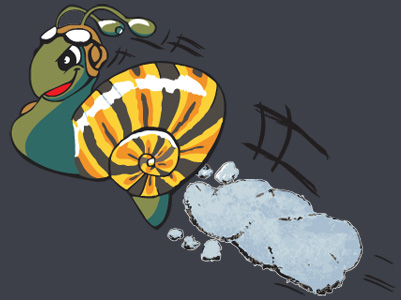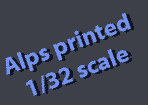



Between 1965 and 1967, Switzerland built 17 Mirage IIIRS "AMIR" under license. The aircraft were registered R-2102 to 2118, whilst R-2101 was French built and delivered to Switzerland by Dassault Aviation (AMD). The Mirage IIIRS replaced the ageing DH. 112 Venom. All reconnaissance Mirages were assigned to Squadron 10 based at Dübendorf during peacetime and dispersing to Buochs, Payerne and Sion, their allotted wartime basis during annual repetition courses.
Originally, the reconnaissance Mirages carried the standard factory livery, natural metal with a red trim and a black anti-glare panel. Only R-2101 sported a black camera nose and Mirage IIIRS titles, which were painted below the cockpit. The red painted areas behind the cockpit and around the air intakes disappeared after a short time and only narrow red bands remained for safety reasons at the very forward edge of the intake. On top of the wing, the red stripes were removed but the speed brakes were kept red.
Once in service and due to the fact that the reconnaissance aircraft operated mainly at low level, a two tone green/grey over light grey color scheme was adopted; the air intakes and speed brakes retained the red color. Along with the change of the camouflage scheme, the Squadron 10 logo designed by Walter Böhm appeared on both sides of the fin. Originally, camouflaged Amirs carried black numbers but this was changed to white for better visibility. In time, yellow walkways were painted on top of the wings above the wheel wells and even later, the red paint on the speed brakes and air intakes disappeared completely. This scheme was kept until the aircraft retired from service in 2003.
Pilots names, zaps and even sophisticated art work applied by pilots or ground crews appeared from time to time. These were usually quickly removed by the maintenance depot in Buochs or Dübendorf, as they did not adhere to military specifications. This was not the case with Mata Hari however. Being the last of the line, it was tradition to baptize the aircraft and the artwork was maintained with care.
In 1992, two Mirage IIIRS were invited to the ILA airshow in Berlin. During this exhibition a German artist painted the Berlin City Bear logo on the nose of R-2108. It was later removed again during the subsequent 600 hours overhaul, when the aircraft received a fresh paint makeover.
In October 1997, Captain Markus "Zurigo" Zürcher took "Amir" R-2102 to Jever at the invitation of the Jabo Geschwader "F" Friesland. Squadron "F's" pet "Scorpion" was painted below the cockpit as well as the pilots name and call sign.
Thanks to:
Peter
Lewis
Charles Gremion
Markus Zuercher
Rene Schneider
October
2006
Robert
During its service life, the Mirage IIIRS fleet did not see very many imaginative color schemes. The best known were certainly 'Black and White' which appeared in the Spring of 2003. Others include the celebration of the first 3000 flight hours reached with R-2103 in 2001. A large Squadron 10 logo in white and blue was painted on the fin and remained until the end of its service life 3 years later.
Probably the most famous "Amir" was R-2118, named after the enticing spy Mata Hari. The art work depicts an Owl and the title "Mata Hari" in golden letters. Whilst the comparison of the eyesight of an Owl with the cameras carried in the nose is obvious, the silence of an owl in flight and the roar of the Atar 9C are less clear, needless to say having your picture taken by a reconnaissance fighter at the speed of sound would no doubt wipe the smile off ones face. Today, R-2118 is owned by the Air Force museum at Dübendorf air base, but as of 2006 is not displayed publicly due to space restrictions.
Just weeks before the Amir was finally retired after 38 years of service in 2003, they took part in the 2003 NATO Recce Meet competition in Belgium, proving despite their age, that they were still the best by taking the trophy home.
This decal sheet will allow you to create a Mirage IIIRS during its latter years of service as the black numbers and red speed brakes are not included. Please bear in mind, that in 1987, the Amir fleet adopted canards and chaff & flare dispensers along with radar threat receivers. If you therefore wish to build any of the Mirages as depicted on this decal sheet, you will need to include these modifications. The exception to the rule is Mata Hari, as R-2118 can be built without the canards as can any of the "Amir's" without using the special art work.
Also worth a mention is that the roundels and sometimes the Squadron 10 logo were kept looking dirty in order to tone down the white areas. From a distance, it appears on some aircraft, that the roundels were purposely toned down on the wing, both top and bottom. Officially, this was not a fact, but some tests with flat lacquer were performed. Therefore, there are differences between the aircraft and these changed from time to time.
Originally, the aircraft received a complete re-spray every 600 flight hours during major overhauls. During the later years of service however, only small local repairs were done, mainly to the leading edges. Despite the type of paint used not changing throughout the years, later paint schemes appeared to be flatter and lighter.
Please note that the cockpits were painted in a metallic light green color. This is unique to the Swiss Mirages IIIS and RS models.
Some of the Squadron 10 logos have the number 10 painted in them. This was not a set rule, but was not included into the original design. You will have to check your references. Both logos are included.
This decal sheet is printed on a continuous clear decal film with an Oki (Alps) thermo-printer. The wax like paint is very soft and extremely delicate. For protection, the sheet is sealed with a thin coat of Johnson acrylic floor wax. However, further protection is advised. In this case, applications of thin coats of flat finish once the decals are completely dry. Normal softening liquids like Micro Sol / Set will work on this decal film. Nevertheless - a test on a piece of scrap is advised.
A valuable reference and source of information is the "AMIR Mirage IIIRS" book by Reto Seipel and Peter Lewis, available from www.goatworks.com.
Price:
CHF
28.- / € 18.- / £ 11.50 / $ 22.-
SOLD OUT
order directly: info@mc-one.ch